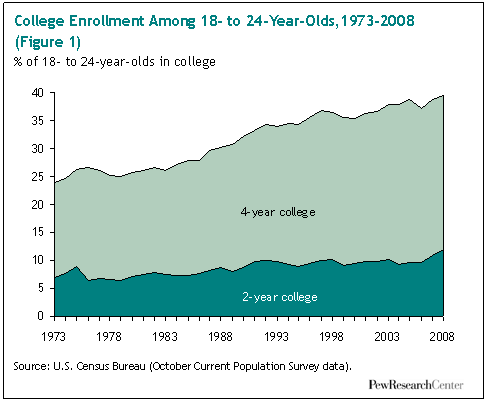Newly released Census Bureau data indicate that college enrollment among 18- to 24 year-olds reached an all-time high last year. In October 2008, 39.6% of 18- to 24-year-olds were in college (Figure 1), an increase from 38.8% in October 2007 and 24.0% in October 1973.3 The relatively high proportion of young adults attending college is due to a recent spike in enrollments at two-year colleges. In October 2008 11.8% of 18- to 24-year-olds were enrolled in two-year colleges, the highest figure for two-year college attendance among that age group on record. In October 2008, 27.8% of 18- to 24-year-olds were enrolled in four-year colleges. This was unchanged from October 2007 (27.9%) and below the October 2005 peak (29.2%).
Among 18- to 24-year-olds, two-year colleges educated about 30% of college students in October 2008, not much different from the 29% share they educated in 1973.

The size of the total 18- to 24-year-old population in 2008 (29 million) was close to its all-time high attained in 1981,4 so the high college enrollment rate in 2008 also led to a record in the absolute number of young adults attending college. Almost 11.5 million 18- to 24-year-olds were enrolled in college in 2008, the highest figure ever (Appendix Table A1).5
This peak in college enrollment is occurring concurrently with difficult labor market prospects facing youths. Recent news accounts have noted that the employment rate among 16- to 24-year-olds is at its lowest level since the government began collecting the data in 1948. And labor force participation for that age group is at its lowest level since at least 1970.
Further analysis is needed to determine the extent to which the recent increase in community college enrollment among 18- to 24-year-olds is explicitly related to the current recession, which officially began in December 2007. Previous research has shown that community college enrollments tend to rise as labor market conditions deteriorate and unemployment rates rise (Betts and McFarland, 1995). But recent movements in both college enrollment and labor force participation might also reflect longer-running trends. College enrollment among youth has been rising since 1980 (Turner, 2004), and labor force participation among younger people has been declining since the mid-1980s (Juhn and Potter, 2006). Moreover, schooling and work are not mutually exclusive endeavors. About half of young full-time college students are either working or looking for work.




